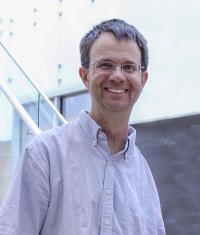by Rachel Kaufman

What happens when things get cold? Not just chilly--when you put on a scarf and mittens--or midnight-in-Antarctica cold--but really, really cold?
The answer to that question is why Eric Allin Cornell holds a Nobel Prize.
He, along with Carl Wieman, synthesized the first Bose-Einstein condensate in 1995, a process that requires cooling matter to impossibly cold temperatures. The deep vacuum of space is far too warm for Bose-Einstein condensate; the most advanced cooling techniques of the time were not powerful enough. But if you can get to about 170 nK--about 0.00000017 degrees above absolute zero--some weird things start happening.
Born in Palo Alto in 1961, Cornell grew up in Cambridge where he was "an all-around curious kid," reading books surreptitiously during class and pondering physics brainteasers at night.
As an undergrad at Stanford, Cornell majored in physics, "but I wasn't necessarily gelled there," he tells SPS. "I thought I would pursue something more on the humanities or social sciences side."
Ultimately, it was a summer and after-school job that tipped the scales, as well as a year in Asia.
Cornell had taken a year off from college to study Chinese and teach English in Taiwan, but ultimately returned from that experience realizing that physics was something he enjoyed--and was good at. Meanwhile, he'd been spending afternoons and summers working with the low-temperature physics groups to earn money. "The [physics] classes were OK," Cornell says. "It was really the after-school and summer thing that I found so thrilling. That was, I would say, really the thing that made me think I wanted to go and do physics."
After grad school at MIT, he moved to a postdoc position at JILA, where his experience and interest in low-temperature physics would lead him to the discovery that would win him his Nobel Prize.
"During those early years in Boulder, I spent a lot of time trying to imagine what a Bose-Einstein condensate would be like, if we could ever make one," he wrote. After his postdoc ended, he stayed at JILA to work on creating Bose-Einstein condensate.
BEC is essentially a new form of matter, predicted by Satyendra Nath Bose and Albert Einstein in 1924 to occur when atoms are cooled to almost absolute zero. Physicists had been struggling to create BEC ever since to confirm Bose and Einstein's theory.
In 1992, when Cornell joined JILA as a professor, "the idea of BEC was in the air," Cornell once wrote.
"We were pretty optimistic in the face of a lot of skepticism," he tells SPS. "We had some good arguments for why it would work--or I thought they were good arguments."
Creating BEC at JILA required using laser and magnetic traps to bring a cluster of rubidium atoms to near-absolute zero. But even 10 millionths of a degree above absolute zero is too warm to create BEC, so getting the substance cold enough took some doing.
Inspired by advisor-then-supervisor Carl Wieman, Cornell would tinker with equipment using off-the-shelf parts ripped from fax machines or CD drives. "It was the fastest way. If you could put something together really fast like that, why bother to order some exotic thing that might or might not work?"
By then, speed was an important consideration. By the mid-90s, skepticism in the scientific community had given way to excitement; Cornell says he was less worried about not succeeding and more worried "that people were going to beat us to the punch."
But in 1995, Cornell, Wieman and the JILA team first created and observed BEC. Doing so not only confirmed a 71-year-old theory but also opened up a new branch of physics.
"As things get colder, their quantum mechanical nature tends to get more pronounced," Cornell says. "They get wavier and wavier and less like particles. The waves of one atom overlap with another atom and form a giant superwave, like a giant, Reagan-esque pompadour."
Hair metaphors aside, BEC is a way for physicists to observe quantum phenomena on, as Wieman has said, "an almost human scale." The BEC behaves like one giant atom which allows physicists to study it in greater detail than ever before.
For this discovery, Cornell and Wieman shared the 2001 Nobel Prize, along with Wolfgang Ketterle, whose team at MIT created BEC a few months after the JILA team.